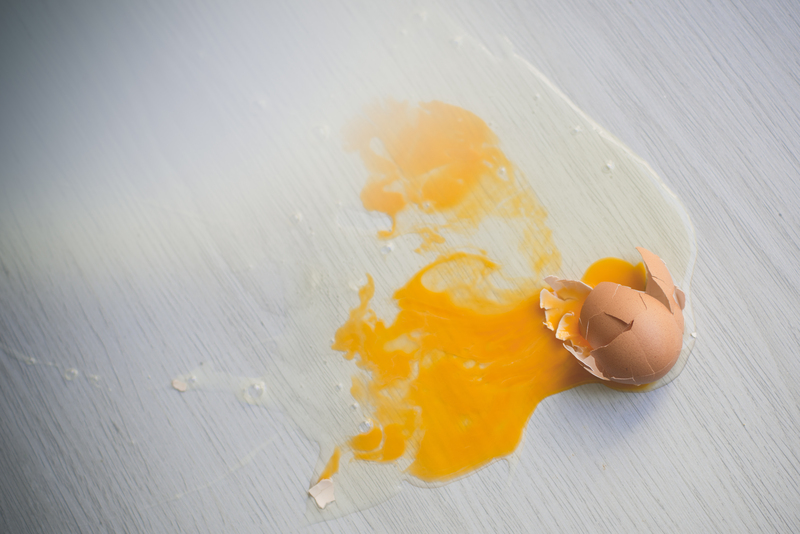Achieve a Pristine Stovetop with Burnt-Residue Cleaning Tips
Posted on 19/06/2025
Achieve a Pristine Stovetop with Burnt-Residue Cleaning Tips
A sparkling kitchen speaks volumes about your home's overall cleanliness-- and at the very heart of any kitchen lies the stovetop. Over time, grease splatters, stubborn stains, and burnt-on residue can mar its surface, turning even the newest appliance into an eyesore. But do not worry! With expert advice and practical solutions, achieving a pristine stovetop, even after multiple culinary mishaps, is entirely possible. In this comprehensive guide, you will discover the best burnt-residue cleaning tips and learn how to restore your cooker to its original shine--ensuring it remains a pride of your kitchen for years to come.
Why Is It Important to Clean Burnt Residue from Your Stovetop?
Before diving into the cleaning methods, let's understand why addressing burnt-on residue is crucial:
- Safety: Accumulated burnt food and grease can ignite, posing a serious fire hazard.
- Performance: A clean stovetop ensures your burners operate efficiently, offering consistent heat distribution.
- Hygiene: Old food particles attract insects and bacteria, which compromises your kitchen's cleanliness.
- Aesthetics: Nothing beats the look of a glossy, pristine stovetop in your culinary space.
- Longevity: Regular cleaning prevents corrosion and prolongs the life of your appliance.

Understanding Your Stovetop Surface
Not all stovetops are created equal! Knowing your specific type--gas, electric, glass, or ceramic--can significantly impact your burnt-residue cleaning approach. Here's a quick breakdown:
- Gas Stovetops: Comprise metal grates, burners, and often removable drip pans. Burnt spills can become baked-on quickly due to high heat.
- Electric Stovetops: Feature coiled heating elements with removable drip plates underneath. Burnt residue and sugary spills can damage and stain coils if left unattended.
- Glass/Ceramic Stovetops: Prized for their sleek appearance, but also infamous for easily showing stains and requiring gentle, non-abrasive cleaning methods.
Each stovetop type requires specific cleaning techniques to avoid scratches, discoloration, or permanent damage. Always consult your manufacturer's manual before beginning any deep cleaning regimen for burnt residues.
The Essential Supplies for Stovetop Burnt-Residue Removal
Gathering the right cleaning supplies sets the stage for success. For most stuck-on spills and soot, you'll need:
- Baking soda
- White vinegar
- Dish soap (grease-cutting)
- Non-scratch sponges or scouring pads
- Plastic scraper
- Microfiber cloths or soft towels
- Rubber gloves
- Old toothbrush (for intricate parts and crevices)
- Warm water
Optional but helpful:
- Lemon juice (natural degreaser)
- Commercial stovetop cleaner
- Razor blade scraper (glass or ceramic surfaces only, with care)
Step-by-Step Guide: How to Clean Burnt Residue from Your Stovetop
1. Preparation and Safety
- Turn off all burners and allow the stovetop to cool completely before starting the cleaning process.
- Unplug the appliance if possible, especially for electric units.
- Remove grates, knobs, burner caps, and any other removable components.
- Lay towels on nearby countertops to protect surrounding surfaces during cleaning.
2. Soak Removable Parts
- Place grates, drip pans, and burner caps in a sink filled with hot, soapy water.
- Allow them to soak for 15-20 minutes to loosen burnt-on grease and food particles.
- Scrub with a non-abrasive pad or brush, then rinse and air-dry.
3. Remove Loose Debris
- Gently sweep away crumbs or loose burnt pieces using a soft brush or damp cloth.
- For glass and ceramic cooktops, take extra care to avoid scratching the surface.
4. Treat Burnt-On Stains
-
For Metal or Porcelain:
- Mix equal parts baking soda and water to form a paste.
- Apply the paste generously to burnt spots.
- Let it sit for 15-30 minutes to break down residue.
- Scrub gently with a non-scratch pad, then wipe clean with a damp cloth.
-
For Glass or Ceramic:
- Sprinkle baking soda over stubborn stains.
- Spray with white vinegar to create a bubbling reaction.
- Lay a hot, damp towel over the treated spots for 15 minutes.
- Wipe away softened residue with a soft microfiber cloth or use a specialized glass scraper at a 45-degree angle for burnt sugar stains.
5. Degrease the Surface
- Mix a tablespoon of dish soap in two cups of warm water.
- Dampen a sponge and wipe the entire surface to remove oily residues left behind after scrubbing.
- Always rinse with clean water and dry thoroughly to avoid streaks.
6. Final Buff and Polish
- For that pristine finish, buff with a clean, dry microfiber cloth.
- On glass stovetops, a drop of specialty cleaner will amplify the final shine.
Natural Alternatives for Stubborn Burnt Spots
If you prefer to avoid harsh chemicals, don't worry. Some effective, eco-friendly alternatives work wonders for burnt residue removal:
- Lemon Juice: Its acidity cuts through grease and lifts stains. Rub half a lemon over burnt areas and let the juice sit for 10 minutes, then wipe clean with a damp towel.
- Vinegar and Baking Soda: This classic combo loosens hardened residue and neutralizes odors.
- Salt Paste: Mix kosher salt with a bit of water to create a gentle abrasive paste. Useful for cast-iron grates or iron burner caps.
Dealing with Extra Tough Stains
Some spills, like sugary syrups or melted plastics, require special care, particularly on glass and ceramic stovetops.
- Wait until the burnt spot cools slightly, but is still warm.
- Carefully use a razor blade scraper held at a 45-degree angle, pushing residue away without gouging the surface.
- Apply a baking soda and vinegar mix to lift any remaining residues.
- Finish by polishing with a dedicated glass cooktop cleaner.
_Important:_ Never use harsh abrasives, steel wool, or metal scouring pads on delicate surfaces--they will cause permanent scratches. Always err on the side of gentleness.
Preventing Burnt Residue and Stains on Your Stovetop
Prevention is the best kind of cleaning. To keep your stovetop pristine and minimize the need for deep scrubbing:
- Wipe spills immediately after the surface cools. The less time food has to burn on, the easier it is to clean.
- Use well-fitted pots and pans--oversized cookware prevents drips from reaching the burners.
- Deep clean grates, burner caps, and drip pans weekly to prevent buildup.
- Install burner liners (where safe and compatible) to catch drips before they burn on the stovetop below.
- Check and clean around knobs and switches where grease often hides.
Creating a Routine Maintenance Schedule
- Quickly wipe the stovetop after each use.
- Do a more thorough clean once a week--remove components and treat stains before they harden.
- Every few months, deep clean all parts and inspect for any wear, rust, or malfunctions.
Choosing the Best Cleaning Products: DIY vs. Commercial Cleaners
While household staples like baking soda and vinegar remain king for most tasks, various commercial stovetop cleaners offer powerful solutions for persistent burnt-on stains:
- Cerama Bryte, Weiman, or Bar Keeper's Friend: Highly recommended for glass and ceramic stovetops, their formulations safely dissolve mineral deposits and burned spills.
- Degreasing sprays: Effective on stainless steel or enamel but should never be used on glass or ceramic surfaces unless specified.
Whether you prefer DIY or commercial products, always test your cleaner on a small, inconspicuous area to ensure no discoloration or etching occurs.
Cleaning Tips for Gas vs. Electric vs. Glass Stovetops
- Gas Stovetops: Scrub grates and caps separately, de-clog burner holes with a toothpick, and never submerge ignition switches in water.
- Electric Coils: Wipe with a damp cloth only when disconnected; avoid soaking them to prevent electrical damage. Remove drip pans underneath and soak or replace when needed.
- Glass/Ceramic: Always use non-scratch tools, never abrasive agents, and avoid heavy objects that can crack the surface.
Common Mistakes to Avoid When Cleaning Burnt Residue
- Skipping Safety Steps: Accidentally turning on burners or cleaning a hot surface risks burns or electric shock.
- Using Metal Tools: Can scratch and permanently mar glass, ceramic, or polished metallic finishes.
- Excess Water: Letting water drip into electrical units can cause failures or hazards.
- Leaving Harsh Chemicals Unrinsed: Residues can release fumes when the stovetop is next used and corrode the surface over time.
Maintaining That Like-New Shine: Long-Term Stovetop Care
- Regularly buff surfaces with a dedicated stovetop polish to maintain lustre and repel new spills.
- Inspect connections (gas hoses, electric contacts) and clean debris to prevent operational issues.
- Replace worn-out parts, such as grates and burner caps, if they become severely corroded or pitted.

Frequently Asked Questions About Burnt Residue Stovetop Cleaning
How Often Should I Deep Clean My Stovetop?
For most households, a deep clean once a week, with a wipe-down after every use, keeps burnt residue at bay. Heavy cooker? Increase your cleaning frequency.
Can I Use Oven Cleaner on the Stovetop?
Most oven cleaners are too harsh for stovetops, especially glass, ceramic, or painted metal. Always refer to product instructions and test on a small area first.
What If the Burnt Residue Won't Come Off?
Persistent stains may require several applications of baking soda paste or a safe commercial cleaner. For glass cooktops, a razor blade typically completes the job-- just remember to use a gentle angle and pressure.
Is It Safe to Use Steel Wool on My Stovetop?
It's best not to use steel wool on any stovetop coating, as it can irreparably scratch the finish. Stick to softer, non-abrasive pads.
Conclusion: Enjoy a Pristinely Clean Stovetop Everyday
*Achieving a pristine stovetop after battling burnt-on residue is a matter of commitment and the right techniques*. With these expert burnt-residue cleaning tips, you can rejuvenate every type of stovetop--gas, electric, glass, or ceramic--without risk of scratches or discoloration. Regular care, prompt spill response, and choosing the safest methods tailored for your surface will help maintain your kitchen's heart in immaculate condition. Start building your stovetop cleaning routine today and let your culinary adventures continue on a spotless, gleaming canvas!
```



